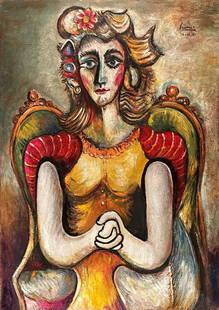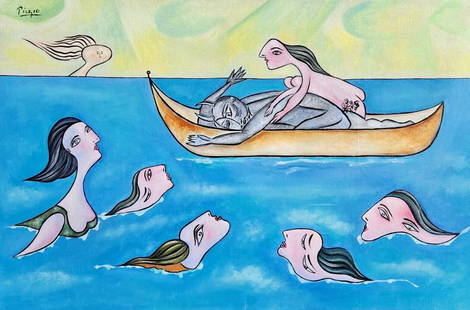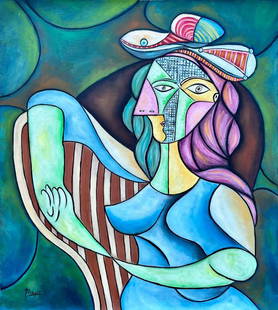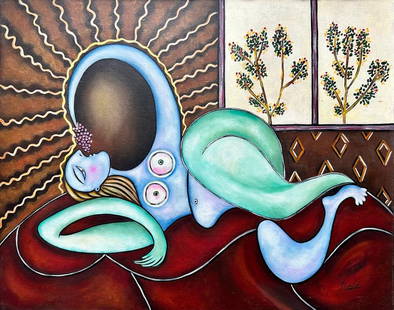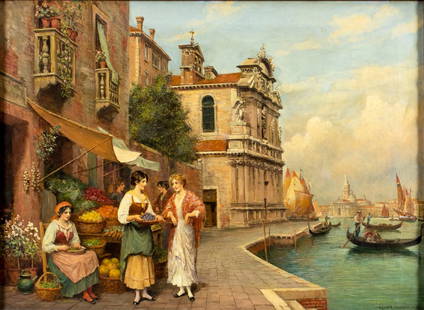
Amazing Hilla Rebay Oil Canvas
Similar Sale History
View More Items in PaintingsRelated Paintings
More Items in Paintings
View MoreRecommended Art
View More



Item Details
Description
Attributed to Hilla Rebay, it does not have a COA. Medium: oil canvas. 28 x 21.5 inches. Provenance: private owner. 1890 - 1967. A woman credited largely for the existence of the Solomon R. Guggenheim Museum in New York City, Hilla Rebay also was an accomplished artist in modernist styles that included collage and biogmorphic-linear oil paintings. She is remembered primarily for being the key person in first exposing the American public to avant-garde art and creating revolutionary museum environments for that art. To remind the public that Rebay was an artist in her own right, curators at the Guggenheim Museum held a retrospective of her work in the spring and summer of 2005.Hilla Rebay (pronounced reh-bye) was born to minor nobility in Strasbourg, Alsace and had the full name of Baroness Hildegard Anna Augusta Elisabeth Rebay von Ehrenwiesen. Her father, a career army officer from Bavaria, and her mother encouraged her obvious childhood art talent. She studied locally and then enrolled in 1909 at the Academie Julian in Paris.There she was much influenced by avant-garde movements especially theosophist artists and writers led by Wassily Kandinsky "who helped formulate her lifelong belief in the power of intuition in art-making and other areas of life" (Glueck). In 1910, she spent time in Munich where she was further exposed to modern art, and she returned to Paris in 1913, having exhibited work in Cologne and Munich. In Paris she studied at the Academie Julian.By 1914, she was exhibiting with the Secession Group in Munich, the Salon des Independants in Paris, and the November Gruppe in Berlin--all rebelling against prevalent realism and traditional teaching methods. In Berlin, she associated with many modernist artists including Vasily Kandinsky, Paul Klee, and Marc Chagall. In 1917, she med Rudolph Bauer, a German painter in non-objective styles who became her long-time lover and in the future the cause of controversy because she was accused of devoting disproportionate exhibition space to him at the Guggenheim Museum. It was said that her enthusiasm for him and his work was "unbounded" (Glueck) and that he inspired her paintings "alive with restless, jostling, organic forms" (Glueck).Hilla Rebay first visited the United States in 1927 and stayed for an extended time period, which included giving painting lessons to Louise Nevelson, seeking portrait commissions, designing posters and exhibiting her own work at venues including the Worcester Art Mluseum and a Manhattan gallery. Among her portrait commission subjects was Solomon Guggenheim, whose wealthy family had extensive western mining interests. Rebay had met Solomon and his wife Irene when they purchased two of her paintings at the Manhattan show. To that time, the couple were collectors of conventional art, but during the sittings, Hilla talked to him of what was going on in avant-garde art circles. She brought painters of leading-edge styles to meet Guggenheim and encouraged him to collect their art, which he did--filling his Plaza Hotel apartment.Rebay supervised the collection, and in 1937, she led the establishment of a Guggenheim foundation to build "The Museum of Non-Objective Art," achieved in 1939 in rented gallery space on 54th Street. The main focus of the collection was works of the Dutch De Stijl Group that included Piet Mondrian and Theo van Doesburg, and of Bauhaus artists from Germany such as Paul Klee, Vasily Kandinsky, and Laszlo Moholy-Nagy.Although she was committed to purely non-objective works, she added to the collection abstract works by George Seurat, Henri Matisse, Henri Rousseau, Pablo Picasso, and others in France who were experimenting with Cubism, Futurism, etc.The Foundation directors bought land between 88th and 89th Streets on Fifth Avenue and commissioned Frank Lloyd Wright to design a museum building. The collection was temporarily housed in a mansion on the grounds, and Hilla, who had a strong interest in mysticism, "created an unforgettable, hushed, other worldly atmosphere . . . People coming in from the noise and bustle of the streets found themselves transported into a seemingly higher spiritual dimension" (Rubinstein). There was gray fabric on the walls, plain, minimal frames on the paintings, and Bach music in the background---all creating a sense of quiet refinement and revolutionary for a museum setting.During this time, Rebay was reaching out to many young non-objective American artists including Jackson Pollock and Rudolf Bauer who had emigrated from Germany, by giving them money and exhibiting their work.She was also at the center of controversy from a a variety of sources. Left-wing activists made fun of her mysticism; reactionaries found her much too liberal; and most of her critics thought she was way too autocratic. Of that era, she has been described as "a complicated dynamic woman, take-charge and bossy, who aroused jealousy in the art world by her closeness (though it was probably not romantic) to Guggenheim." (Glueck). In addition, she was disdained during World War II because she was German and was accused of being a German spy, rumors that were promoted by Rudolf Bauer, whom she and others thought was jealous of her position with Guggenheim.In 1951, two years after Guggenheim's death, Hilla Rebay resigned as Director but remained a trustee of the collection, and lived in Greens Farms, Connecticut. During her career as an administrator, she had continued as a painter and created canvases of geometric shapes and ones that expressed pure color and rhythm. She also authored several books including one titled "Wassily Kandinsky", and wrote articles for the "Carnegie Institute Magazine" and "Southern Literary Digest. " However, her enduring reputation is for her influence in bringing non-objective art to America.
All authorship of items in this catalog are described according to the following terms:
Signed [Artist Name] : In cases in which the signature is legible in the lot, this work is described as-is with no attributions given.
By [Artist Name] : The work is by the artist.
Attributed to [Artist Name] : The work may be ascribed to the artist on the basis of style, but there may be some question as to actual authorship.
In the manner of [Artist Name] : The work was executed by an unknown hand, but was designed deliberately to emulate the style of the artist.
After [Artist Name] : The work was executed by an unknown hand, but is a deliberate copy of a known work by the artist.
Circle of [Artist Name] : A work of the period of the artist showing his influence, closely associated with the artist but not necessarily his pupil.
Follower of [Artist Name]: A work by a pupil or a follower of the artist (not necessarily a pupil).
American, 19th century: This work was executed by an unknown hand, and can only be identified by origin (i.e., region, period).
All authorship of items in this catalog are described according to the following terms:
Signed [Artist Name] : In cases in which the signature is legible in the lot, this work is described as-is with no attributions given.
By [Artist Name] : The work is by the artist.
Attributed to [Artist Name] : The work may be ascribed to the artist on the basis of style, but there may be some question as to actual authorship.
In the manner of [Artist Name] : The work was executed by an unknown hand, but was designed deliberately to emulate the style of the artist.
After [Artist Name] : The work was executed by an unknown hand, but is a deliberate copy of a known work by the artist.
Circle of [Artist Name] : A work of the period of the artist showing his influence, closely associated with the artist but not necessarily his pupil.
Follower of [Artist Name]: A work by a pupil or a follower of the artist (not necessarily a pupil).
American, 19th century: This work was executed by an unknown hand, and can only be identified by origin (i.e., region, period).
Condition
Mint, based on the description
Buyer's Premium
- 25% up to $200.00
- 25% up to $300.00
- 25% above $300.00
Amazing Hilla Rebay Oil Canvas
Estimate $6,000 - $12,000
11 bidders are watching this item.
Get approved to bid.
Shipping & Pickup Options
Item located in Riverview, FL, usSee Policy for Shipping
Payment
Accepts seamless payments through LiveAuctioneers

TOP

























